Virtual Staging AI Guide to Transforming Spaces
Discover how virtual staging AI can instantly transform empty rooms. Learn to use the best AI tools to visualize furniture in your actual space before you buy.
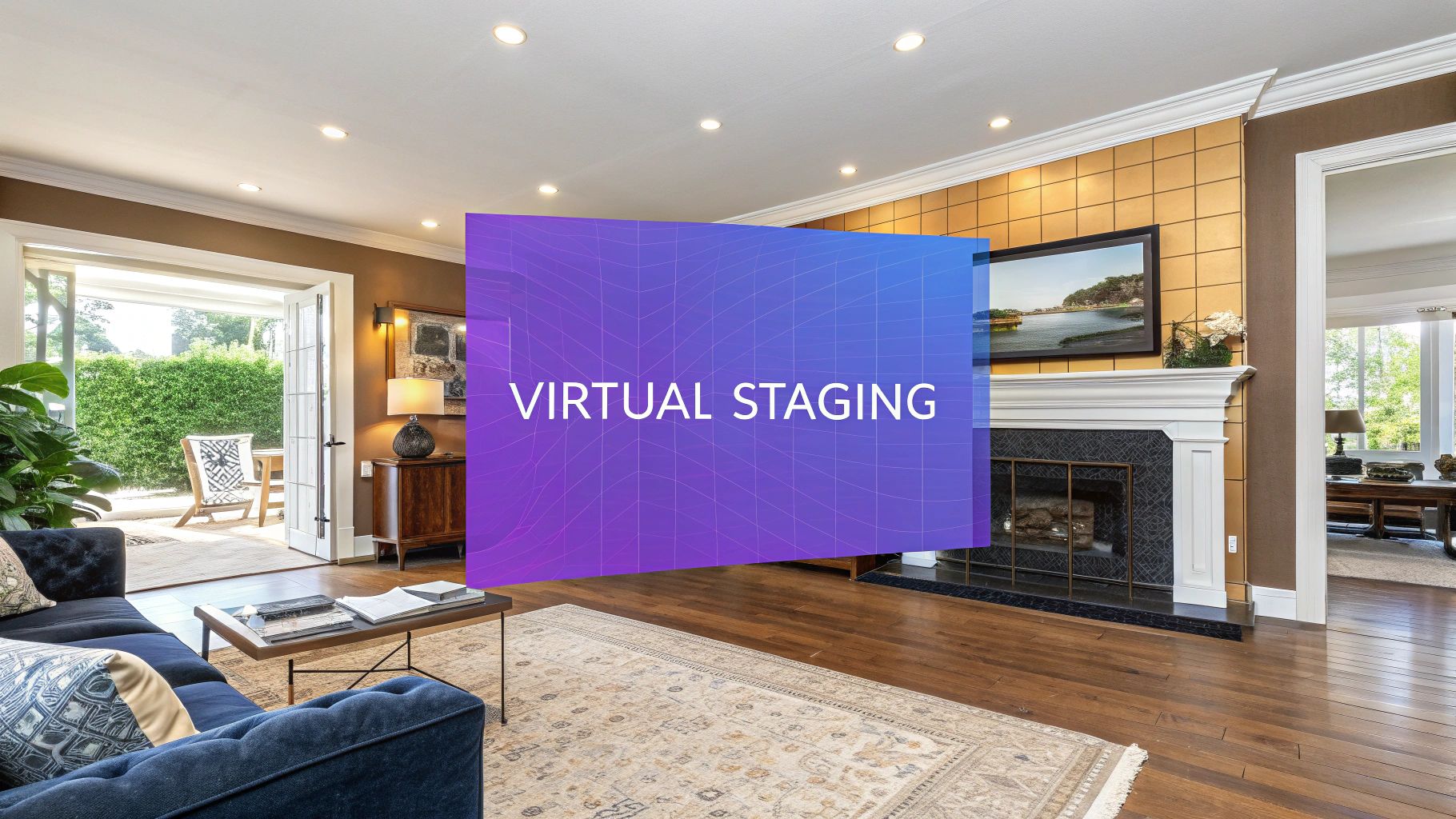
Imagine having an expert interior designer on call, ready to furnish any room in minutes with real furniture you’re actually thinking of buying. That's the core idea behind virtual staging AI. It's a technology that uses artificial intelligence to digitally place furniture and decor into a photo of an empty or maybe just outdated room. It’s not just a cool trick; it's a powerful tool that completely changes how potential buyers and homeowners see and connect with a space.
What Exactly Is Virtual Staging AI?
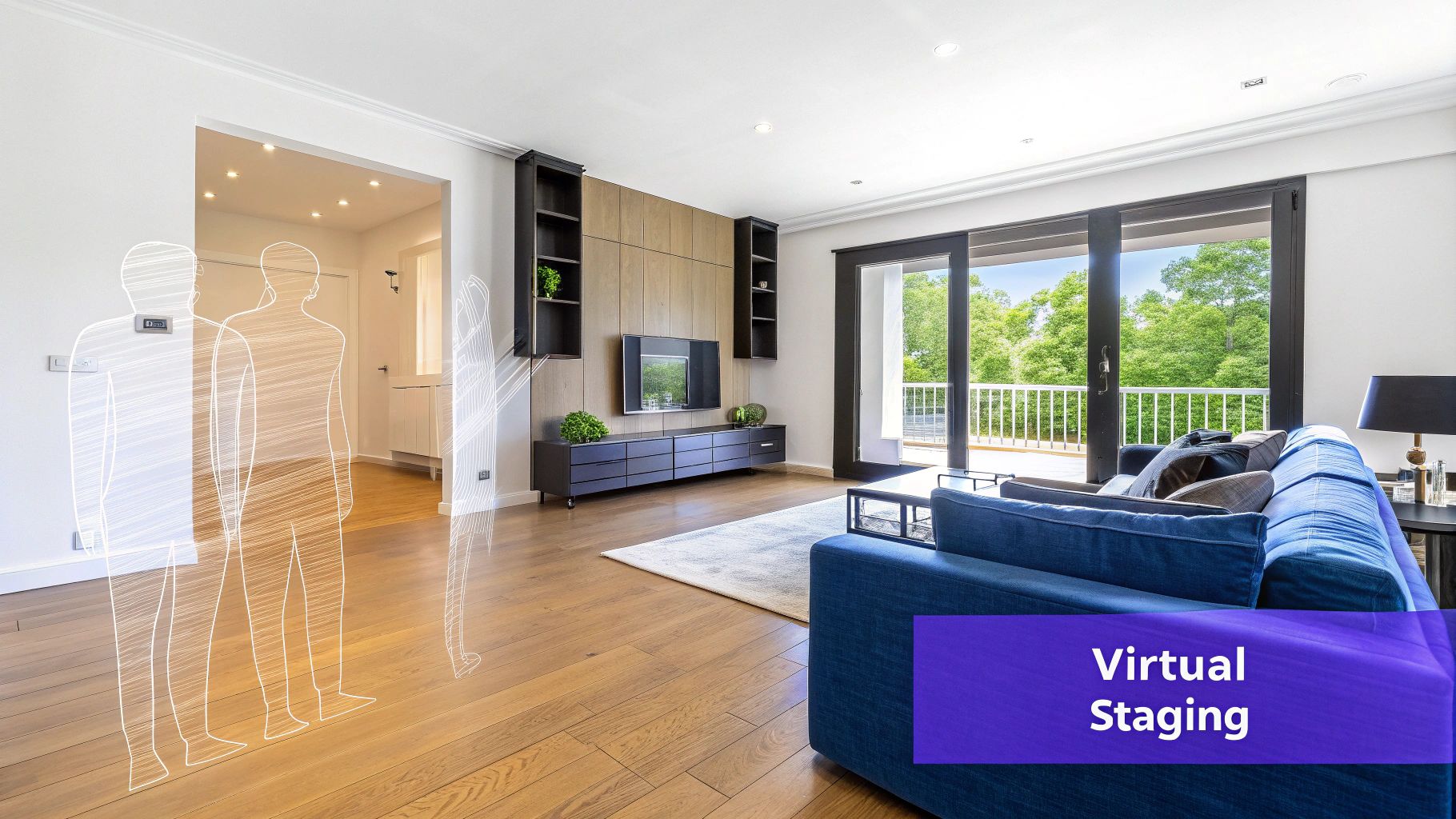
It’s best to think of virtual staging AI less like complex software and more like a smart design assistant. You simply start with a photo of your space. The AI then gets to work, analyzing everything—the walls, the floors, the lighting, the room’s dimensions—to get a real feel for its layout and character.
From there, it generates an incredibly realistic image showing what the room could look like with new furniture and decor. This is so much more than just pasting objects onto a picture. The AI creates a lifelike scene that helps people truly imagine themselves living there.
How Does It Work with Real Products?
This is where things get really interesting for homeowners and designers. Modern platforms like aiStager have made this process shockingly simple. You don't need to be a tech wizard or have a design degree to use it.
You just need three things:
- A photo of your room.
- The room’s dimensions.
- A web link to a real product you're interested in.
With just a photo of the room and a link to a product, aiStager lets any user place real interior products into any photo. The AI takes that information and builds a true-to-scale visualization, showing you exactly how that specific piece of furniture would look in your home. This lets you quickly test different interior ideas with real products and finishes, completely taking the guesswork out of the equation.
The real beauty of virtual staging AI is how it breaks down old design barriers. It lets anyone play around with high-end styles or practical layouts on the fly, so you can make confident design choices without ever having to move a heavy sofa.
Testing and Comparing Design Ideas
The real magic of a tool like aiStager is the freedom to experiment. Fast. Wondering if a sleek, Mid-Century Modern vibe is right for your living room? In just a few clicks, you can place a new product in your room—just by uploading a photo of the room and a link to the product. You could drop a beautiful West Elm Axel Leather Sofa right into your photo.
Or maybe you’re leaning more towards a relaxed, Japandi aesthetic. No problem. You can instantly swap that out for a minimalist Floyd Sectional and see which one you connect with. It’s not just about different brands or styles, either.
aiStager is great to quickly test different interior ideas with real products and finishes. You can even test different versions of the same product, like different colors and materials. You could place the same sofa model in your room, first in a neutral beige fabric and then in a bold navy velvet, and compare them side-by-side. The AI creates these hyper-realistic photos where the room and furniture are true to scale, so what you see is what you’d get.
This is a complete game-changer from the old way of doing things. In fact, before you even get to the staging part, you can use related tools with AI background removal capabilities to prep an image by clearing out clutter. With this kind of technology now in everyone's hands, placing any real product into any photo with just a link and dimensions means you can test ideas quickly and buy with total confidence.
From Physical Movers to AI Magic
To really get why virtual staging AI is such a game-changer, you have to look at how far we've come. For years, the only option was old-school physical staging, which was a logistical nightmare.
Think about it: renting furniture, hiring movers, paying designers to spend days—or even weeks—arranging everything just so. It was slow, expensive, and rigid. If a potential buyer hated the mid-century modern vibe you paid a fortune for, you were stuck. There was no "undo" button.
Then came the first wave of digital tools like Photoshop. This was a definite improvement, cutting out the physical labor and some of the cost. But it was still a painstaking manual process that required a skilled graphic designer. The results often felt... off. You'd see furniture that looked like it was floating, with weird shadows and a flat, "pasted on" feel.
This infographic really puts the differences into perspective, showing just how much things have changed in terms of cost and speed.
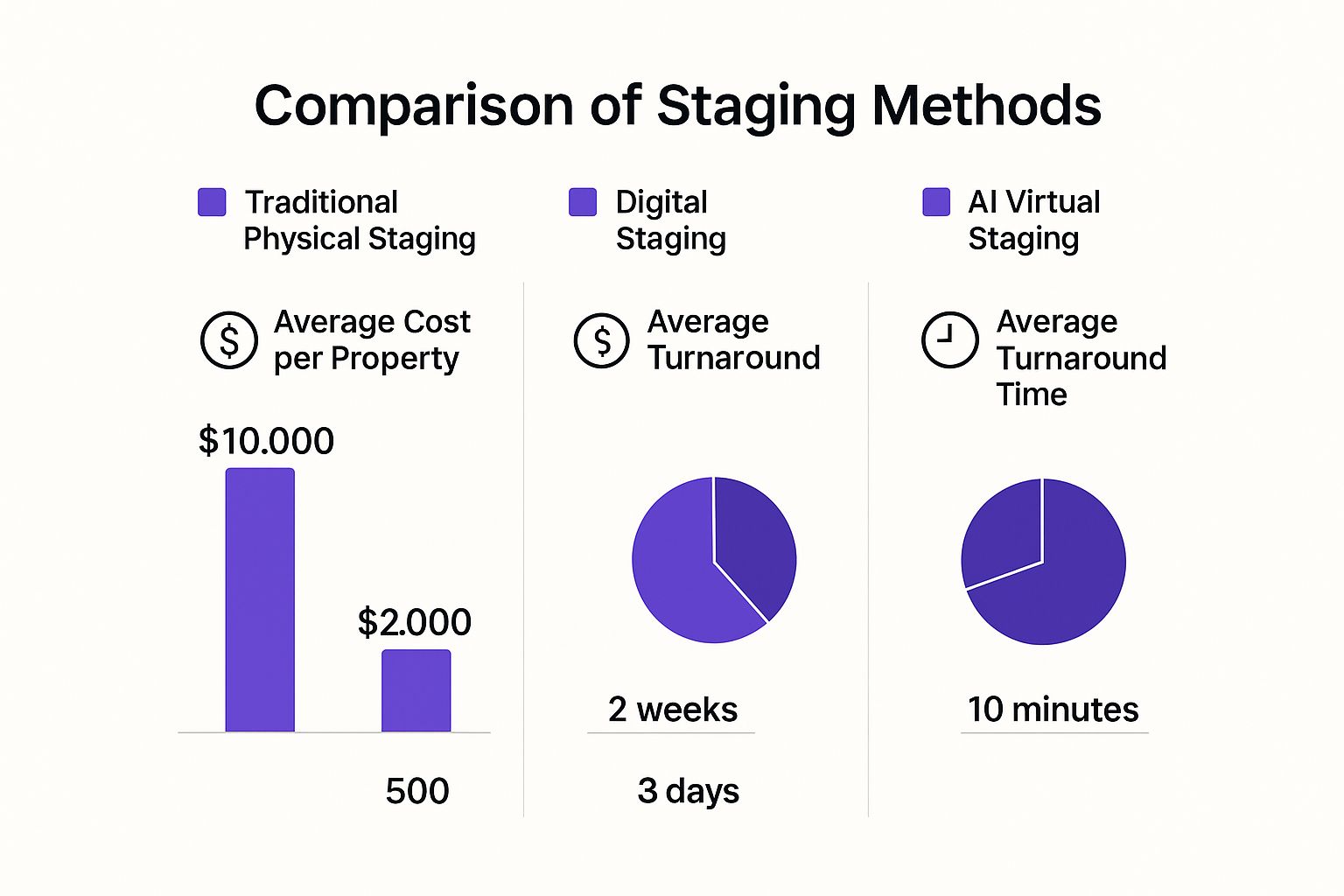
As you can see, AI isn't just a small step forward; it's a massive leap in both efficiency and affordability.
The New Era of Intelligent Design
Welcome to the AI era. Today’s virtual staging is so much more than just fancy image editing. It uses powerful machine learning and generative AI, trained on millions of interior photos, to handle the entire process intelligently. It’s not just about plopping a sofa into a picture anymore.
Modern AI actually understands things like perspective, lighting, and style. It creates hyper-realistic images because it can calculate how an object should look within the true dimensions of a room. This breakthrough solves the biggest headaches of the past, making beautiful, believable staging accessible to everyone—and fast.
The industry has certainly taken notice. The global virtual staging market is booming, with projections showing a compound annual growth rate of up to 18.5% through 2033. In North America, more than 70% of real estate agents are already using these tools. And for good reason: 67% of homebuyers say immersive visuals are a top priority when they're searching for a home. Explore more trends about the growth of virtual staging.
Personalizing Spaces with Real Products
This is where a tool like aiStager really changes the game, not just for agents but for homeowners and design enthusiasts, too. The platform lets you place real products from actual brands into your own photos. All you need is a picture of your room, its dimensions, and a link to the product you've been eyeing online.
Let's say you're trying to nail that cozy, modern farmhouse look for your living room. You can upload your photo and a link to a specific sofa you love, like the Arhaus Kipton Sectional. But you can't decide on the fabric.
With aiStager, you can see exactly how the Kipton looks in a light linen finish. A moment later, you can swap it for a rich charcoal. This isn't just some generic 3D model—it's a dimensionally accurate version of that exact product, in your room.
This opens the door to endless, commitment-free experimenting. You can try out different design inspirations, from a sleek West Coast Modern style to a more traditional East Coast vibe, all in a matter of minutes. Because aiStager generates photos with true-to-life dimensions for both rooms and furniture, you can finally decide with confidence which piece, color, and finish is the perfect fit for your home.
Why AI Staging Is a Game-Changer
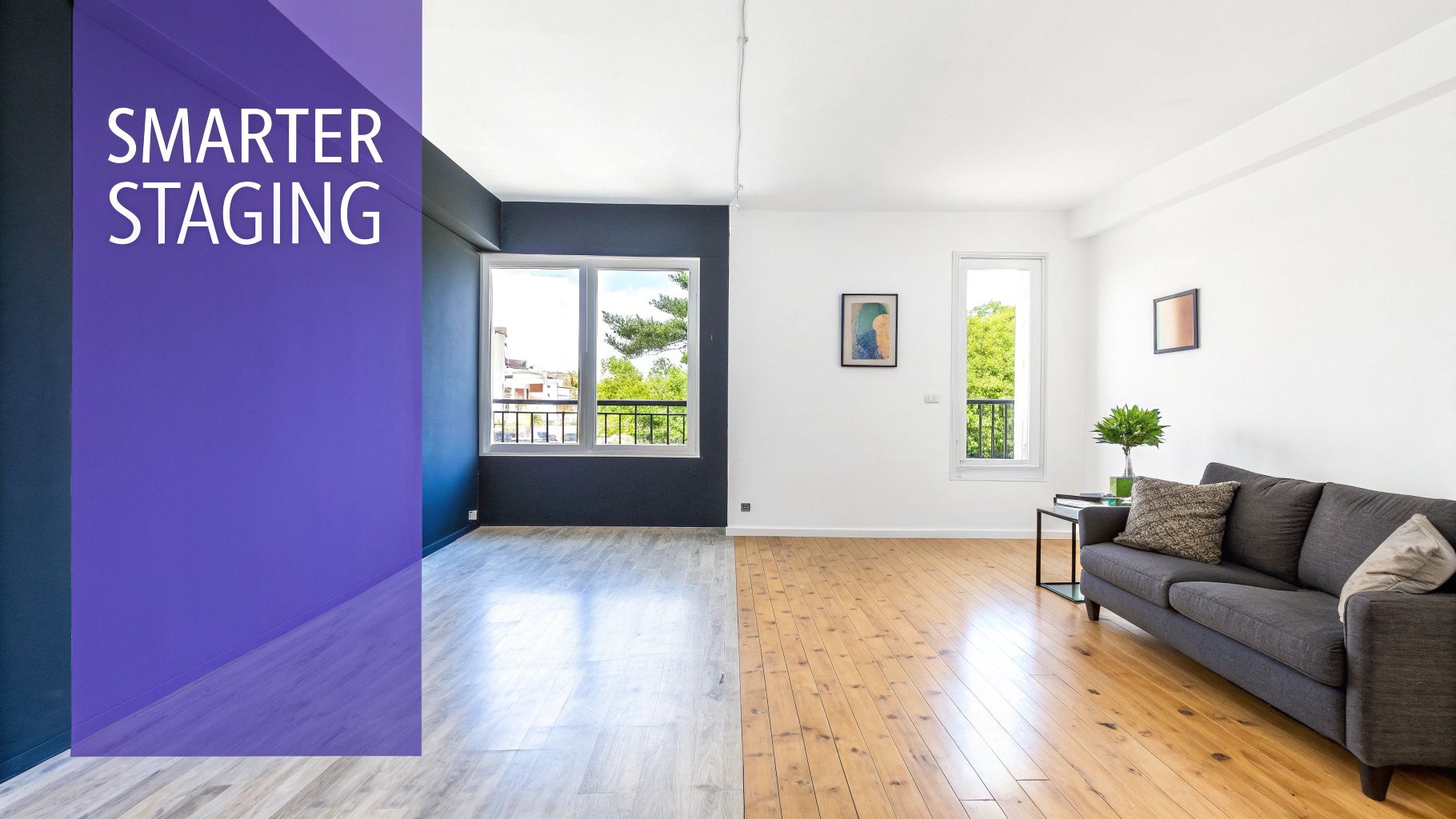
The real magic of virtual staging AI isn’t just the technology itself—it’s how it solves real-world problems. It's more than just a cool trick; it's a practical tool that saves money, sparks creativity, and gives your marketing a serious boost.
Anyone who's dealt with the headaches of physical staging knows the drill: expensive furniture rentals, coordinating movers, and weeks of planning. AI staging completely sidesteps that logistical nightmare.
But the benefits go far beyond just saving time and money. AI-powered platforms give you a level of creative freedom that simply wasn’t possible before. It’s a game-changer for real estate agents, but also an incredibly powerful tool for homeowners who want to make design decisions with total confidence.
Let's dive into a few ways these platforms stack up against the old-school methods. I've put together a quick table to show you what I mean.
Comparing Staging Methods
| Feature | Traditional Physical Staging | Manual Digital Staging | AI-Powered Virtual Staging |
|---|---|---|---|
| Cost | $1,500 - $10,000+ per project | $30 - $300 per image | $15 - $50 per image |
| Time | 1-3 Weeks (planning & execution) | 1-3 Days per image | Under 5 Minutes per image |
| Flexibility | Very Low (one style, physical limits) | Moderate (revisions take time) | Extremely High (instant style changes) |
| Revisions | Costly & Time-Consuming | Possible, but slow | Instant and easy |
| Realism | 100% (it's real) | Varies (can look fake) | Hyper-realistic (with good AI) |
| Scalability | Difficult (limited by inventory) | Moderate (limited by artists) | Highly Scalable (unlimited designs) |
As you can see, AI staging really pulls ahead in key areas like speed, cost, and the sheer ability to experiment without consequence.
Unlock Endless Creative Freedom
Imagine trying to pick the perfect sofa, but you're stuck between two totally different styles. With old-school methods, you'd just have to guess and hope for the best. With virtual staging AI, you can try out every single idea in minutes.
This is where a platform like aiStager really shines. It's the only solution that generates hyper-realistic photos with true dimension rooms and furniture objects. That dimensional accuracy means what you see is actually what you'll get.
For example, maybe you're picturing a clean, modern vibe for your family room. You can instantly see how a sleek ‘Article Sven Sofa’ would look. But what if a more traditional style is calling your name? No problem. In a click, you can swap it for a classic ‘Pottery Barn Chesterfield’ to see which one truly fits the space.
Experiment With Real Products and Finishes
This isn't just about swapping styles; you can get down to the smallest details of a specific product. This is a huge advantage for homeowners and interior shoppers. All aiStager needs is a link to a product from any website and a photo of your room with its dimensions.
Let's say you've found the sofa, but now you're agonizing over the color. This is where the guesswork disappears.
- You can place the sofa in a safe, neutral beige to see how it blends in.
- Instantly switch to a bold navy blue to create a dramatic focal point.
- Even compare different finishes, like a textured linen versus a smooth velvet.
You're no longer trying to imagine how a tiny fabric swatch will look on a full-sized couch. You see the final result in a photorealistic image.
The core benefit here is confidence. By visualizing a real-world product in your own home—down to the exact color and finish—you can buy it knowing it’s the perfect fit.
Boost Marketing Appeal and Emotional Connection
For real estate pros, the end goal is simple: help buyers imagine a house as their future home. An empty room is just a box. It's hard for people to grasp the scale or see its potential.
Virtual staging AI bridges that gap by telling a story. It transforms a vacant property into a warm, inviting space that feels lived-in and full of possibility.
When you showcase a room's potential, you help buyers connect on an emotional level. You’re not just selling four walls; you’re selling a lifestyle. You can even target different buyer tastes. For instance, staging a living room with trendy bohemian living room ideas could catch the eye of a younger, more artistic crowd.
This stronger presentation doesn't just get more clicks—it often leads to faster sales and better offers. When buyers can truly see themselves in a space, their perception of its value goes way up.
See How Virtual Staging AI Is Used Every Day
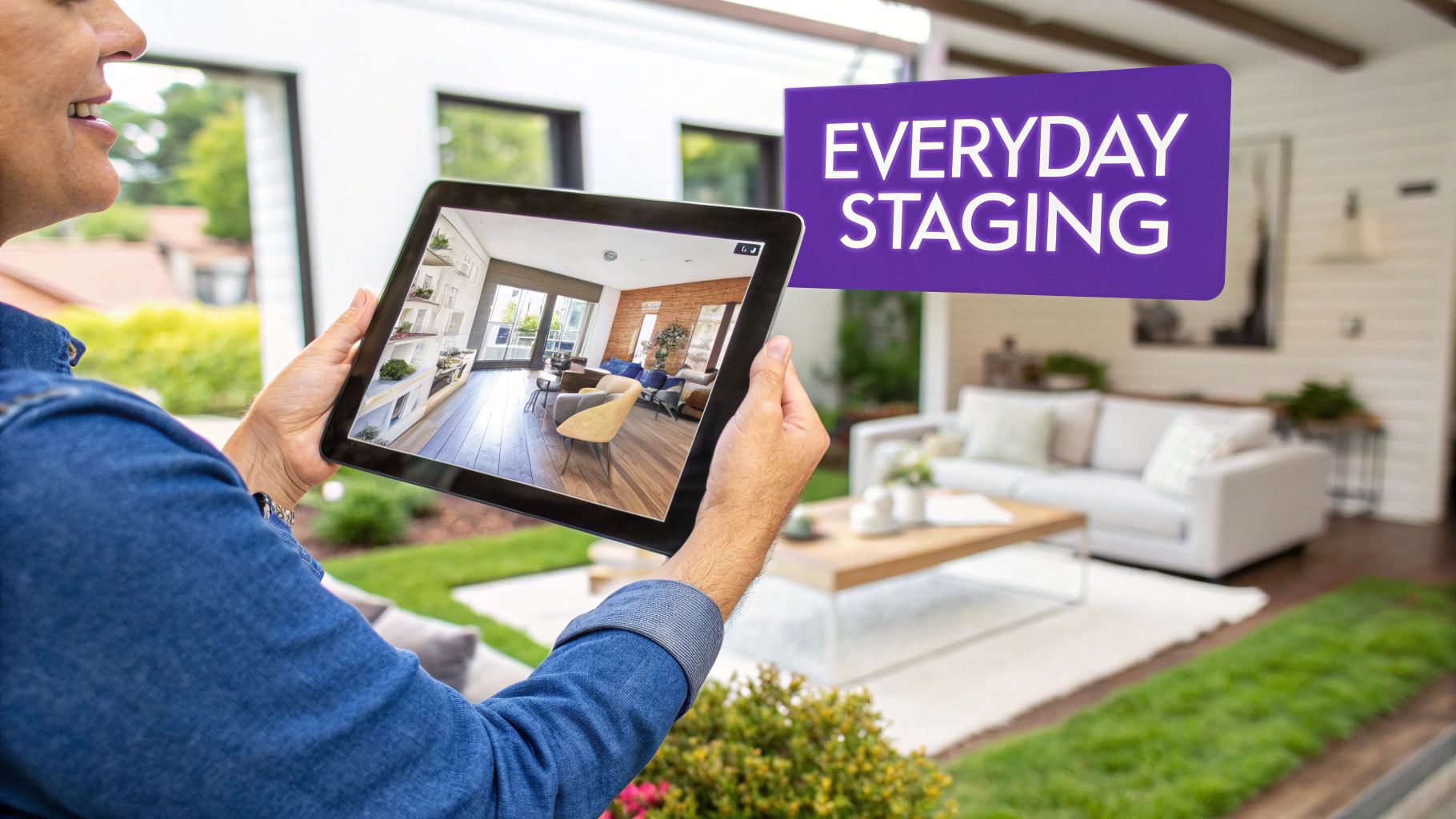
It’s one thing to talk about virtual staging AI in theory, but where does the rubber meet the road? This technology isn't just some high-tech gimmick; it's a practical tool that people are using every single day, from seasoned real estate pros to homeowners just trying to liven up a room.
For a real estate agent, the value is immediate. Let's say you're trying to sell a sleek, modern condo, but it's completely empty. You can use AI to stage it with trendy, inviting furniture from a retailer like Crate & Barrel to help first-time buyers picture themselves living there. Suddenly, an empty box becomes a warm, stylish home.
Interior designers, on the other hand, live and die by speed and client feedback. Instead of spending days building out a complex 3D model, a designer can now show a client three totally different concepts for their master bedroom in a single afternoon. This makes the whole process faster and helps clients feel way more confident about the direction. (If you’re curious about how designers map out these early ideas, our guide on the interior design bubble diagram is a great place to start.)
For the Everyday Design Enthusiast
But maybe the most exciting application is for regular people. Picture this: a homeowner wants to create a cozy reading nook and has their heart set on a design classic—the Herman Miller Eames Lounge Chair. But they're stuck. Will it look too big? Will the wood clash with the floor?
This is where a tool like aiStager changes the game. It’s incredibly simple.
- Snap a photo of the empty corner.
- Plug in the room’s dimensions so the scale is right.
- Copy and paste the link to the chair from the Herman Miller website.
In moments, aiStager spits out a photorealistic image of that exact chair sitting right there in their nook, perfectly to scale. No more guesswork. This ability to drop specific, real-world products into your own space takes all the anxiety out of buying furniture online. It makes design fun again.
The real magic here is moving beyond generic furniture libraries. When you can use actual products from any store, you’re not just visualizing a style—you’re literally test-driving a purchase in your own home.
Testing Ideas with Real-World Products
This is what truly sets modern virtual staging AI apart. It’s not about just filling a room with random stuff; it's about making smart, confident decisions. Imagine you're redoing the living room and know which sofa you want, but you can't decide on the material.
With aiStager, you just upload a photo of your living room and the product link. First, you can see what the sofa looks like in a durable charcoal fabric—perfect for a family with kids. Then, with a few clicks, you can swap it for a rich tan leather to see if it gives the room a more upscale feel. Having that side-by-side comparison is priceless.
This kind of AI-powered workflow is a big reason why virtual home staging software has blown up in the real estate tech world. By combining AI with cloud computing, companies can now offer incredibly fast staging with less manual work and at a lower cost. And with new tech like VR and AR getting mixed in, it's opening the doors for everyone from agents to designers and homeowners to create immersive property tours.
At the end of the day, aiStager’s real strength is generating these hyper-realistic images where both the room and the furniture are true to scale. That precision means what you see is what you’ll get, giving you the confidence to design, buy, and create a space you'll truly love.
How to Choose the Right AI Staging Tool
https://www.youtube.com/embed/nVyD6THcvDQ
With so many virtual staging AI tools popping up, it can be tough to know which one to pick. They all promise amazing results, but how do you cut through the marketing fluff and find a platform that actually works for you?
The secret is to focus on what really matters. When you dig into the details, you'll find that the best tools stand out in four key areas. Getting this choice right means you’ll end up with visuals that are not just pretty, but genuinely compelling and effective.
First Things First: Realism and Quality
This is the absolute most important factor. A poorly staged photo with weird shadows or furniture that just doesn't look like it belongs can backfire, making a property look cheap or fake. You need visuals that are so realistic they’re practically indistinguishable from a professionally shot and staged room.
This is where a tool like aiStager really shines. It’s the only solution that generates hyper-realistic photos with true dimension rooms and furniture objects. This commitment to accuracy ensures that everything—from the lighting to the shadows and the scale of each object—looks just right. The final image feels like a real photograph, not a digital render.
Is It Actually Easy to Use?
A powerful tool is worthless if you need a technical manual to figure it out. The whole point of AI is to make things simpler. The best platforms have a clean, intuitive interface that guides you from an empty room to a stunningly staged photo in just a few minutes.
You shouldn't have to be a 3D artist to get great results. Think about the workflow. For example, aiStager’s process is as straightforward as it gets. All you need are three things:
- A photo of your empty room.
- The room's measurements.
- A link to the exact product you want to place in the room.
This simple approach empowers anyone, from a busy real estate agent to a curious homeowner, to experiment with design ideas on the fly. It's this kind of user-friendliness that's fueling the virtual staging market's massive growth, which is expected to expand at a 26.4% CAGR. As the tech gets easier to use, more industries are jumping on board. You can read more about the virtual staging solutions market growth.
Look for Features That Solve Real Problems
Not all AI staging tools are built the same. A lot of them give you a limited library of generic 3D furniture models to work with. That might be fine for a quick, basic staging, but it’s not helpful if you want to see how a specific, real-world item looks in your space.
So, ask yourself what you really need. Is a random gray sofa good enough, or do you want to see how that beautiful leather sectional from West Elm will actually fit? That's the key difference with a platform like aiStager—it lets you use any product from any website.
This capability is a total game-changer. It means you can try out real products and finishes without ever leaving your home. Imagine comparing a sofa from Pottery Barn to one from Article, seeing exactly how each one looks in your living room before you commit to buying.
Don't Forget to Compare Pricing and Value
Last but not least, take a look at the cost. The best platforms offer clear, flexible pricing that matches how you plan to use it. Many use a credit-based system, which is a great, cost-effective way to pay for exactly what you need, whether you're staging one room or a hundred.
But remember, value is about more than just the price tag. A slightly more expensive tool that delivers photorealistic, dimensionally accurate images with real products is worth far more than a cheap alternative that produces unconvincing fakes. A great image can help a home sell faster or save you from a costly design mistake.
By weighing realism, usability, and features against the price, you can confidently find the perfect virtual staging ai tool. To see how all these pieces fit together in one platform, you can explore aiStager's unique capabilities and see the difference for yourself.
Got Questions About Virtual Staging AI? We've Got Answers.
As virtual staging AI starts popping up more and more, it's only natural to have a few questions. This isn't just a niche tool anymore; it's changing how we shop for furniture, plan our living spaces, and even sell homes.
So, let's clear the air. We’ll walk through some of the most common questions to show you how these tools really work and what makes them so useful.
How Realistic Can AI Virtual Staging Actually Look?
This is usually the first thing people ask, and for good reason. The short answer? The best AI platforms today produce images that are incredibly difficult to tell apart from professional photos. The realism has taken a massive leap forward.
The secret sauce is the AI's knack for getting the little details right—things like light, shadows, textures, and most importantly, scale. This is where advanced tools like aiStager really shine, because they don't just guess. They build the scene using the true dimensions of your room and the exact size of the furniture.
Sure, you might have seen some older digital staging that looks fake or like something was just clumsily "pasted" into a photo. But modern AI is far more sophisticated, blending every new object into the scene so it looks like it belongs. The result is a photo that feels completely real and genuinely inspiring.
Can I Stage a Room with Specific Furniture I Find Online?
Yes! This is a huge feature that really separates the great tools from the merely good ones. Many virtual staging services give you a stock library of generic 3D furniture models. That’s fine for a quick mock-up, but it doesn't help much if you've got your eye on a specific piece.
This is exactly the problem that platforms like aiStager were built to solve. It's designed to let anyone drop real products into a photo. All it takes is a link to the product's webpage and a picture of your room with its dimensions. The AI does the heavy lifting, analyzing the product and creating a perfectly scaled model you can move around your space.
This is a total game-changer for homeowners and interior design lovers. It means you can actually see how that specific sofa from West Elm looks next to your window, or if that cool dining table from a boutique shop like Lulu and Georgia fits your space before you buy it.
With aiStager, you can compare different furniture ideas in minutes. Wondering about two different chair brands? Or maybe just different fabrics for the same armchair? Just upload a photo, drop in a link, and see for yourself. It takes all the guesswork out of the equation.
Isn't It Deceptive to Use Virtual Staging in Real Estate?
That's a fair question, and one the industry takes seriously. The golden rule is transparency. It’s standard practice to always disclose when an image has been virtually staged. You'll usually see a small note like "Virtually Staged" or "Image has been digitally enhanced."
The goal isn't to trick anyone. It’s about helping people see the potential in an empty or dated room. It answers practical questions running through a buyer's mind, like, "Will my king-sized bed fit in here?" or "How would I even arrange furniture in this living room?"
By showing a room beautifully furnished, you help buyers make an emotional connection and get a much better feel for the property's size and layout. When it's done openly and honestly, virtual staging AI is a powerful and ethical marketing tool that genuinely helps the buying process, not hurts it.
What's Next for This Technology?
The future of virtual staging AI is all about becoming more immersive, more personal, and more interactive. The technology is moving fast, and we're on the cusp of some seriously cool developments.
Here's a glimpse of what's on the horizon:
- Real-Time Interaction: Imagine virtually touring a home and swapping out furniture, changing paint colors, and restyling a room on the fly. AI will make this kind of instant feedback possible.
- Augmented Reality (AR) Integration: It'll soon be normal to use your phone's camera to "place" a virtual sofa right in the middle of your actual living room. This is the ultimate "try before you buy" experience.
- Predictive Design: AI will get smarter, suggesting furniture layouts and design styles based on a home’s architecture, its location, and even the type of buyer it’s likely to attract.
As these advancements roll out, tools like aiStager will continue to blur the line between the digital and the real, making great interior design easier and more intuitive for everyone.
Ready to see how a real product would look in your own space? With aiStager, you can stop guessing and start visualizing. Just upload a photo, provide a product link, and get a hyper-realistic, true-to-scale image in seconds. Try it for free and make your next design decision with complete confidence.